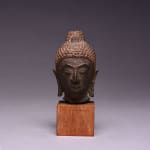Sukhothai Bronze Head of Buddha, 14th Century CE - 15th Century CE
Bronze
7.3 x 4.4 cm
2 7/8 x 1 3/4 in
2 7/8 x 1 3/4 in
FZ.345
Further images
Historically, the Sukhothai kingdom is regarded as the first Thai kingdom. According to legend, the city of Sukhothai was founded in 1238 A.D. by two Thai chieftains who rebelled against...
Historically, the Sukhothai kingdom is regarded as the first Thai kingdom. According to legend, the city of Sukhothai was founded in 1238 A.D. by two Thai chieftains who rebelled against their Khmer overlords and established their own independent kingdom. One of these chieftains became the first king of Sukhothai, known from then on as Sri Indraditya. The kingdom quickly expanded its territory by force as well as through a network of marriage alliances with neighboring Thai states. By the reign of Ramkhamhaeng, the younger son of Sri Indraditya, the kingdom had become one of the most powerful states in Southeast Asia. Its borders now stretched from Burma in the west to Laos in the east and the Malay peninsula in the south. The era of Sukhothai, which literally means “dawn of happiness,” is generally considered to be the cradle of Thai culture, and Ramkhamhaeng is revered as the father of the Thai nation.
While the Sukhothai kingdom was initially indebted to Khmer art and architecture, as is evident in the earliest ruins of the city, over time the kingdom became increasingly influenced by the art and religion of Sri Lanka, all the while maintaining a uniquely Thai character. Under the Sukhothai Dynasty, the Ceylonese school of Theravada Buddhism flourished and the major cities of the kingdom became centers of Buddhist learning complete with magnificent monasteries. Sukhothai style Buddhist sculptures are famed for their stylized elegance. Sukhothai artists are also noted for introducing the form of the “walking Buddha” into the cannon of Buddhist sculpture. Although this era is considered to be a golden age of Thai culture, the kingdom began to decline after the death of Ramkhamhaeng, due in part to the rise of Lan Na as well as the breakdown of a number of principalities into independent states.
Small, but precious, this mounted Buddha head possesses the stylistic features characteristic of Sukhothai sculptures, including the arching brows that merge into the bridge of the nose and the gently undulating lines of the eyelids and smiling mouth. Round-curled hair covers the head and topknot, which was understood as a cranial protuberance by many Southeast Asians. An effigy is carved on the top center of the head to symbolize perfect wisdom.
All the spirituality of Buddhism is contained in this figure, as much in the gently spreading smile on the smooth face, as in the meditative, pious, inward-looking expression which is emphasized by the closed eyes. His reflective and mysterious demure reflects the Buddhist ideal of an upright and charitable life, in which all desire is suppressed and total detachment achieved. This Buddha is a model of gentle humanity.
While the Sukhothai kingdom was initially indebted to Khmer art and architecture, as is evident in the earliest ruins of the city, over time the kingdom became increasingly influenced by the art and religion of Sri Lanka, all the while maintaining a uniquely Thai character. Under the Sukhothai Dynasty, the Ceylonese school of Theravada Buddhism flourished and the major cities of the kingdom became centers of Buddhist learning complete with magnificent monasteries. Sukhothai style Buddhist sculptures are famed for their stylized elegance. Sukhothai artists are also noted for introducing the form of the “walking Buddha” into the cannon of Buddhist sculpture. Although this era is considered to be a golden age of Thai culture, the kingdom began to decline after the death of Ramkhamhaeng, due in part to the rise of Lan Na as well as the breakdown of a number of principalities into independent states.
Small, but precious, this mounted Buddha head possesses the stylistic features characteristic of Sukhothai sculptures, including the arching brows that merge into the bridge of the nose and the gently undulating lines of the eyelids and smiling mouth. Round-curled hair covers the head and topknot, which was understood as a cranial protuberance by many Southeast Asians. An effigy is carved on the top center of the head to symbolize perfect wisdom.
All the spirituality of Buddhism is contained in this figure, as much in the gently spreading smile on the smooth face, as in the meditative, pious, inward-looking expression which is emphasized by the closed eyes. His reflective and mysterious demure reflects the Buddhist ideal of an upright and charitable life, in which all desire is suppressed and total detachment achieved. This Buddha is a model of gentle humanity.







